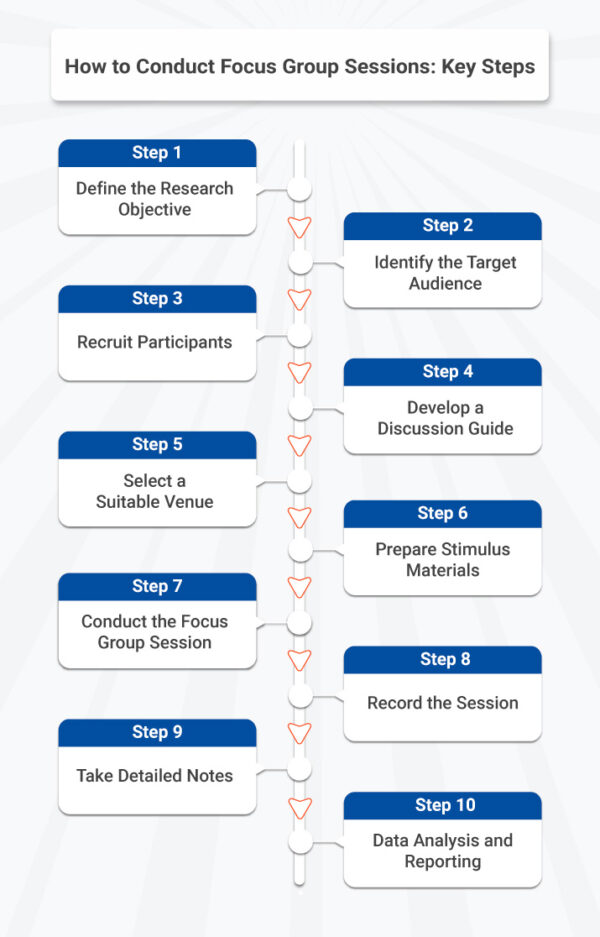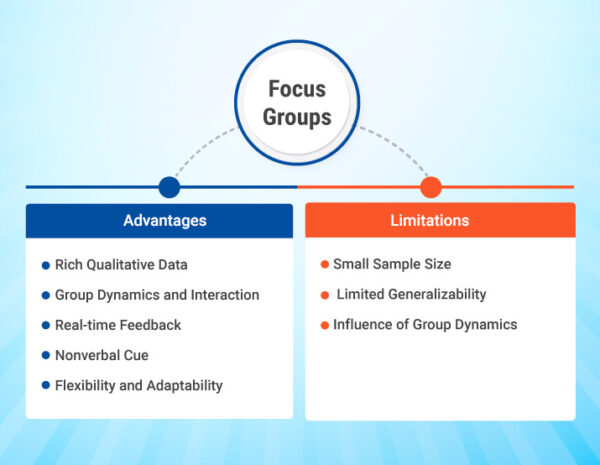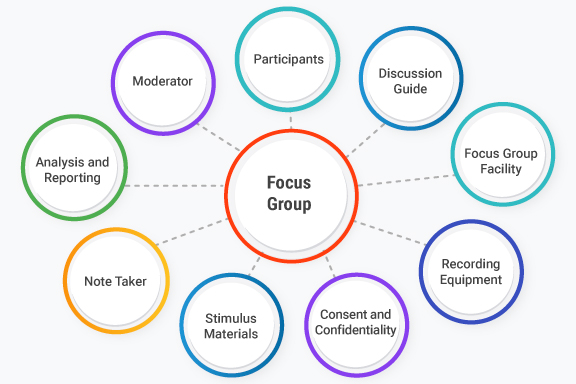Table of Contents
What is a Focus Group?
A focus group, a cornerstone of qualitative research employed in market research and social sciences, gathers a select group of 6 to 10 participants. This method facilitates a guided discussion led by a skilled moderator, aiming to delve into participants’ opinions, perceptions, and attitudes regarding a specific topic.
Conducted in a comfortable and neutral environment, like a meeting room or dedicated research facility, traditional focus groups have evolved to include online sessions, particularly when participants span multiple geographical locations.
Primarily utilized in market research, focus groups serve as a dynamic tool to explore consumer preferences, test novel product ideas, evaluate advertising campaigns, assess customer satisfaction, and collect feedback on existing products or services. The insights garnered from these qualitative discussions empower businesses, organizations, and researchers to make informed decisions, refine strategies, and gain valuable perspectives from their target audience.
Let’s look into the key components that make up a focus group:
- Moderator: A skilled moderator is responsible for guiding the focus group discussion. They facilitate the session, ask open-ended questions, maintain the flow of conversation, and ensure that all participants have an opportunity to express their opinions.
- Participants: A small group of individuals, usually between 6 to 10, who are selected based on specific criteria relevant to the research topic. The participants should represent the target audience or the population of interest, providing diverse perspectives and experiences.
- Discussion Guide: A structured plan or outline that the moderator follows during the focus group. It includes a series of questions, prompts, and topics that guide the discussion and ensure that all relevant areas are covered.
- Focus Group Facility: A physical location where the focus group takes place. It may be a dedicated research facility equipped with observation rooms, one-way mirrors, audio/video recording equipment, comfortable seating, and other amenities. Alternatively, it can be conducted online using video conferencing tools.
- Recording Equipment: Audio or video recording equipment is used to capture the focus group session. This allows for later analysis and ensures accurate documentation of the discussion. It is important to obtain participants’ consent for recording.
- Consent and Confidentiality: Participants are informed about the purpose of the focus group, their role, and the handling of their personal information. They are typically required to sign a consent form indicating their agreement to participate. Confidentiality and anonymity should be maintained, and participants’ identities should be protected.
- Stimulus Materials: Depending on the research objective, stimulus materials such as product samples, prototypes, advertisements, or visual aids may be provided to the participants. These materials can help facilitate discussion and gather more specific feedback.
- Note Taker: In addition to the moderator, there is often a designated note taker who records detailed notes during the session. These notes capture key points, interesting insights, and participant responses, supplementing the audio/video recordings.
- Analysis and Reporting: After the focus group session, the collected data, including recordings and notes, are transcribed and analyzed. Themes, patterns, and commonalities in the responses are identified to generate insights and actionable findings. The results are usually compiled into a comprehensive report or presentation.
By considering these key components and ensuring their proper implementation, focus groups can be conducted effectively to gather valuable qualitative research data and insights.
Learn more: What is Focus Group Research?
How to Conduct Focus Group Sessions: Key Steps

Conducting a focus group session involves several key steps to ensure a well-organized and productive discussion. Here are the key steps involved in conducting a focus group:
Step 1. Define the Research Objective
Clearly articulate the purpose of the focus group and the specific research objectives you want to achieve. Determine what insights or information you hope to gather from the participants.
Step 2. Identify the Target Audience
Determine the characteristics and demographics of the participants you want to include in the focus group. Select individuals who represent your target audience or have relevant experiences and perspectives.
Step 3. Recruit Participants
Use various methods to recruit participants, such as contacting existing customers, using online platforms, working with recruitment agencies, or reaching out to specific communities. Screen potential participants based on predetermined criteria to ensure they fit the desired profile.
Step 4. Develop a Discussion Guide
Create a structured discussion guide that outlines the topics, questions, and prompts you want to cover during the focus group. The guide should flow logically and encourage open-ended responses to facilitate rich discussions.
Step 5. Select a Suitable Venue
Determine the location for the focus group session. It can be a dedicated research facility, a meeting room, or an online platform for virtual focus groups. Ensure the venue provides a comfortable and conducive environment for participants to freely express their opinions.
Step 6. Prepare Stimulus Materials (if applicable)
If you plan to provide stimulus materials, such as product samples, prototypes, or visual aids, gather and prepare them in advance. Ensure they are relevant to the research objectives and will stimulate discussion.
Step 7. Conduct the Focus Group Session
On the scheduled day, welcome participants, explain the purpose of the focus group, and establish rapport with them. Introduce the moderator and any other team members present. Remind participants of confidentiality and obtain their consent for recording (if applicable). Follow the discussion guide, encourage participation, and manage the flow of conversation.
Step 8. Record the Session
Use audio or video recording equipment to capture the focus group session. This allows for accurate documentation and later analysis. Ensure participants are comfortable with the recording and their privacy is protected.
Step 9. Take Detailed Notes
Assign a note-taker to capture important points, participant responses, and notable insights during the session. These notes will complement the recordings and assist in the analysis phase.
Step 10. Data Analysis and Reporting
Transcribe the recorded session and review the notes. Analyze the data to identify common themes, patterns, and insights emerging from the discussions. Use qualitative research and analysis techniques to interpret the data and extract meaningful findings. Next, summarize the key findings, insights, and recommendations in a final report. Ensure to clearly communicate the outcomes of the focus group, including participants’ perspectives, opinions, and suggestions.
Learn more: What is Qualitative Market Research?
Focus Group Examples and Questions
Here are a few example scenarios and corresponding questions that could be used in a focus group:
Scenario 1: Testing a New Product Concept Objective: Gather customer feedback on a new product concept and understand consumer preferences.
Focus Group Questions:
- What are your initial impressions of the product concept?
- How does this product concept compare to similar products already on the market?
- What specific features or benefits of the product concept appeal to you?
- Are there any concerns or drawbacks you see with the product concept?
- How likely are you to purchase and use this product concept? What factors influence your decision?
- Can you suggest any improvements or modifications to make the product concept more appealing?
Scenario 2: Evaluating an Advertising Campaign Objective: Assess the effectiveness of an advertising campaign and understand consumer perceptions.
Focus Group Questions:
- Have you seen or heard the advertising campaign we are discussing? What are your thoughts on it?
- Did the advertising campaign effectively communicate the product or brand message? Why or why not?
- How does the advertising campaign make you feel? Does it resonate with you emotionally?
- Are there any specific elements of the advertising campaign that stood out to you? Why?
- Did the advertising campaign motivate you to take any action or change your perception of the product or brand?
- Is there anything you would suggest changing or improving about the advertising campaign?
Scenario 3: Exploring Customer Satisfaction Objective: Understand customer satisfaction levels, identify areas of improvement, and gather suggestions for enhancement.
Focus Group Questions:
- How satisfied are you with the product/service we provide? What factors contribute to your satisfaction or dissatisfaction?
- Are there any specific aspects of our product/service that stand out to you as exceptional? Why?
- Can you share any instances where you felt our product/service fell short of your expectations? What could have been done differently?
- Are there any additional features or services you would like to see us offer?
- How does our product/service compare to competitors in the market?
- What steps can we take to improve customer satisfaction and enhance the overall experience?
These example scenarios and questions provide a starting point for conducting focus groups in various contexts. Remember to tailor the questions to your specific research objectives and the target audience, ensuring they elicit open-ended responses and promote meaningful discussions.
Advantages and Limitations of Focus Groups

Advantages of Focus Groups:
- Rich Qualitative Data: Focus groups generate in-depth data through qualitative research by allowing participants to express their opinions, attitudes, and experiences in their own words. This provides rich insights that may not be captured through quantitative research methods alone.
- Group Dynamics and Interaction: Focus groups facilitate interaction among participants, allowing for the exploration of differing perspectives, group dynamics, and social influences. The discussion can stimulate new ideas, uncover shared experiences, and generate deeper insights through the exchange of thoughts and opinions.
- Real-time Feedback: The interactive nature of focus groups enables immediate feedback. Participants can react to stimuli, concepts, or ideas at the moment, providing valuable real-time insights that can shape decision-making processes.
- Nonverbal Cues: In addition to verbal responses, focus groups allow for the observation of nonverbal cues such as body language, facial expressions, and gestures. These nonverbal cues can convey additional information and enrich the understanding of participants’ attitudes and emotions.
- Flexibility and Adaptability: Focus groups offer flexibility in terms of question sequencing and the ability to probe deeper into responses. Moderators can adapt the discussion based on participants’ reactions and delve into specific areas of interest, allowing for a more comprehensive exploration of the research topic.
Limitations of Focus Groups:
- Small Sample Size: Focus groups typically involve a small number of participants, usually between 6 to 10 individuals. This limited sample size may not represent the entire population accurately and can lead to potential biases or generalization challenges.
- Limited Generalizability: Due to the small sample size and potential selection bias, the findings of a focus group may not be generalized to a larger population. They provide insights into the perspectives of the specific participants involved but may not reflect broader trends or opinions.
- Influence of Group Dynamics: Group dynamics within a focus group can impact participants’ responses. Dominant individuals may overshadow quieter participants, and social pressures or conformity may influence the expressed opinions. Some participants may hesitate to express dissenting views, leading to a potential bias in the results.
Learn more: What is Customer Experience (CX) Research?
Top 8 Best Practices for Conducting Focus Groups 2023
While the fundamentals of conducting focus groups remain relatively consistent, there are some best practices to consider for conducting focus groups in 2023. Here are the key best practices:
1. Define Clear Research Objectives: Clearly articulate your research objectives and the specific information you aim to gather from the focus group. This will help guide the discussion and ensure the session stays focused.
2. Diverse Participant Recruitment: Strive for diversity when recruiting participants. Aim to include individuals who represent various demographics, backgrounds, and perspectives relevant to your research objectives. This diversity can enrich the discussions and provide a broader range of insights.
3. Consider Online Focus Groups: In light of technological innovation and the COVID-19 pandemic, consider conducting focus groups online using video conferencing tools. Online focus groups offer convenience, accessibility, and the ability to reach participants from different locations. Ensure participants have the necessary technology and a stable internet connection for a smooth session.
4. Use Visual and Digital Stimuli: Incorporate visual and digital stimuli to enhance participant engagement. This can include sharing product images, videos, or interactive digital prototypes during the session. Visual aids can help participants better understand concepts and provide more informed feedback.
5. Create a Comfortable Environment: Whether conducting in-person or online focus groups, create a comfortable and inclusive environment for participants. Establish a respectful atmosphere where participants feel at ease expressing their thoughts and opinions. Encourage active listening, and ensure participants have equal opportunities to contribute.
6. Employ Skilled Moderators: Moderators play a crucial role in facilitating focus group discussions. Ensure moderators have strong facilitation skills, are neutral and unbiased, and can manage group dynamics effectively. Skilled moderators can encourage participation, ask probing questions, and keep the discussion on track.
7. Use Hybrid Approaches: Consider combining focus groups with other research methods to gain a more comprehensive understanding. For example, you could use surveys or interviews alongside focus groups to gather data through quantitative research and validate qualitative findings.
8. Ethical Considerations: Ensure ethical practices by obtaining informed consent from participants, maintaining confidentiality, and protecting participants’ privacy. Adhere to data protection regulations and provide participants with the necessary information about the purpose and handling of their data.
Learn more: What is Qualitative Observation?
Most Recent Blogs
Explore the latest innovation insights and trends with our recent blog posts.










